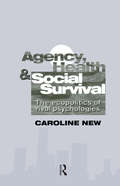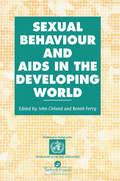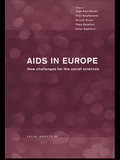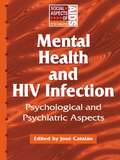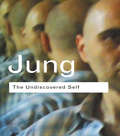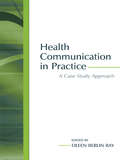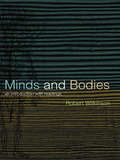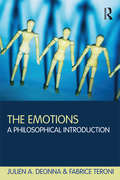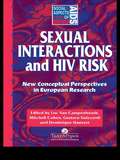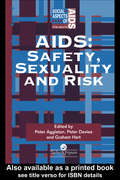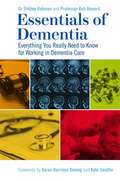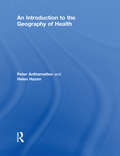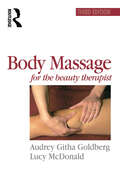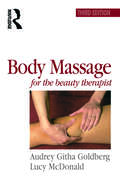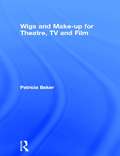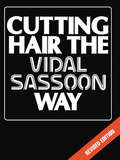- Table View
- List View
Agency, Health And Social Survival: The Ecopolitics Of Rival Psychologies
by Caroline NewThis text addresses the interface of sociology and psychology which, it argues, is the key to political change. Offering a comparison of a range of psychotherapeutic theories of human nature, including those of Freud and Anna Freud, Klein and Kleininans and Lacan, humanisticpsychology, and feminist, trans-cultural and other radical psychotherapies, the book focuses on each theory's psychological concept of health and its political implications.
Sexual Behaviour and AIDS in the Developing World
by John Cleland Benoit FerryBased on the findings of a research project conducted by the World Health Organisation, this book contains unpublished material on AIDS-related knowledge and sexual behaviour in countries in Africa, Asia and South America, including: Cote d'Ivoire; Kenya; Lesotho; Mauritius; Tanzania; Sri Lanka; Singapore; Thailand and Brazil. The book provides an in-depth comparative analysis of the findings from 16 key surveys in the original research programme, the aim of which was to identify baseline levels of sexual and other risk behaviours. The text is intended to be of use to a wide range of readers, including those working in health education, social and behavioural research, anthropology, social medicine and sexual behaviour research.
Sexual Behaviour and AIDS in the Developing World
by John Cleland Benoit FerryBased on the findings of a research project conducted by the World Health Organisation, this book contains unpublished material on AIDS-related knowledge and sexual behaviour in countries in Africa, Asia and South America, including: Cote d'Ivoire; Kenya; Lesotho; Mauritius; Tanzania; Sri Lanka; Singapore; Thailand and Brazil. The book provides an in-depth comparative analysis of the findings from 16 key surveys in the original research programme, the aim of which was to identify baseline levels of sexual and other risk behaviours. The text is intended to be of use to a wide range of readers, including those working in health education, social and behavioural research, anthropology, social medicine and sexual behaviour research.
AIDS in Europe: New Challenges for the Social Sciences
by Peter Aggleton Jean Paul Moatti Annick Prieur Theo Sandfort Yves SouteyrandMajor changes in the nature and dynamics of the AIDS epidemic over the last few years are reflected in changing epidemiological trends as well as in the progress made in biomedical research and treatment. AIDS in Europe brings together papers from leading social science researchers to look at the opportunities and challenges these changes bring and the different ways in which they are being responded to in both western and eastern Europe. Papers are organised under three headings: *new challenges for HIV prevention *care of people living with HIV/AIDS in a new therapeutic context *AIDS public policies: from specialisation to normalisation AIDS in Europe provides a comprehensive overview of current social and behavioural research on HIV and AIDS for all health professionals.
AIDS in Europe: New Challenges for the Social Sciences
by Peter Aggleton Jean Paul Moatti Annick Prieur Theo Sandfort Yves SouteyrandMajor changes in the nature and dynamics of the AIDS epidemic over the last few years are reflected in changing epidemiological trends as well as in the progress made in biomedical research and treatment. AIDS in Europe brings together papers from leading social science researchers to look at the opportunities and challenges these changes bring and the different ways in which they are being responded to in both western and eastern Europe. Papers are organised under three headings: *new challenges for HIV prevention *care of people living with HIV/AIDS in a new therapeutic context *AIDS public policies: from specialisation to normalisation AIDS in Europe provides a comprehensive overview of current social and behavioural research on HIV and AIDS for all health professionals.
Mental Health and HIV Infection
by Jose CatalanMental Health and HIV Infection provides an up-to-date overview of the mental health consequences and of the kind of psychological, psychopharmaological and community forms of intervention available to deal with the adverse psychological effects of HIV infection. Divided into three parts, the book examines psychological and brain-related consequences of HIV infection, key areas of intervention, and three areas of controversial debate: euthanasia, psychoimmunology and complementary therapies. Assuming no specialist psychological, psychiatric or medical knowledge, this book is important reading for caregivers and healthcare workers to HIV positive individuals and their families, nurses, psychologists and counsellors.
Mental Health and HIV Infection
by Jose CatalanMental Health and HIV Infection provides an up-to-date overview of the mental health consequences and of the kind of psychological, psychopharmaological and community forms of intervention available to deal with the adverse psychological effects of HIV infection. Divided into three parts, the book examines psychological and brain-related consequences of HIV infection, key areas of intervention, and three areas of controversial debate: euthanasia, psychoimmunology and complementary therapies. Assuming no specialist psychological, psychiatric or medical knowledge, this book is important reading for caregivers and healthcare workers to HIV positive individuals and their families, nurses, psychologists and counsellors.
The Undiscovered Self: Answers to Questions Raised by the Present World Crisis
by C. G. JungIn The Undiscovered Self Jung explains the essence of his teaching for a readership unfamiliar with his ideas. He highlights the importance of individual responsibility and freedom in the context of today's mass society, and argues that individuals must organize themselves as effectively as the organized mass if they are to resist joining it. To help them achieve this he sets out his influential programme for achieving self-understanding and self-realization. The Undiscovered Self is a book that will awaken many individuals to the new life of the self that Jung visualized.
Health Communication in Practice: A Case Study Approach
by Eileen Berlin RayHealth Communication in Practice: A Case Study Approach offers a comprehensive examination of the complex nature of health-related communication. This text contains detailed case studies that demonstrate in-depth applications of communication theory in real-life situations.With chapters written by medical practitioners as well as communication scholars, the cases included herein cover a variety of topics, populations, contexts and issues in health communication, including:*provider-recipient communication and its importance to subsequent diagnosis and treatment;*decision-making;*social identity, particularly how people redefine and renegotiate their social identity;*communication dynamics within families and with health care providers through unexpected health situations;*delivery of health care; and*health campaigns designed to disseminate health-related information and change behaviors.Reflecting the changes in health communication scholarship and education over the past decade, chapters also explore current topics such as delivering bad news, genetic testing, intercultural communication, grieving families, and international health campaigns. A list of relevant concepts and definitions is included at the end of each case to help students make connections between the scenario and the communication theories it reflects.With its breadth of coverage and applied, practical approach, this timely and insightful text will serve as required reading in courses addressing the application of communication theory in a health-related context.
Health Communication in Practice: A Case Study Approach
by Eileen Berlin RayHealth Communication in Practice: A Case Study Approach offers a comprehensive examination of the complex nature of health-related communication. This text contains detailed case studies that demonstrate in-depth applications of communication theory in real-life situations.With chapters written by medical practitioners as well as communication scholars, the cases included herein cover a variety of topics, populations, contexts and issues in health communication, including:*provider-recipient communication and its importance to subsequent diagnosis and treatment;*decision-making;*social identity, particularly how people redefine and renegotiate their social identity;*communication dynamics within families and with health care providers through unexpected health situations;*delivery of health care; and*health campaigns designed to disseminate health-related information and change behaviors.Reflecting the changes in health communication scholarship and education over the past decade, chapters also explore current topics such as delivering bad news, genetic testing, intercultural communication, grieving families, and international health campaigns. A list of relevant concepts and definitions is included at the end of each case to help students make connections between the scenario and the communication theories it reflects.With its breadth of coverage and applied, practical approach, this timely and insightful text will serve as required reading in courses addressing the application of communication theory in a health-related context.
Minds and Bodies: An Introduction with Readings
by Robert WilkinsonMinds and Bodies is a clear introduction to the mind-body problem. It requires no prior philosophical knowledge and is ideally suited to newcomers to philosophy and philosophy of mind. Robert Wilkinson carefully introduces the fundamental components of the philosophy of mind: Descartes's dualist account of mind and body; monist views including eliminativism; computer science and artificial intelligence. Each chapter is linked to a reading from key thinkers in the field, from Descartes to Paul Churchland.
The Emotions: A Philosophical Introduction
by Julien Deonna Fabrice TeroniThe emotions are at the centre of our lives and, for better or worse, imbue them with much of their significance. The philosophical problems stirred up by the existence of the emotions, over which many great philosophers of the past have laboured, revolve around attempts to understand what this significance amounts to. Are emotions feelings, thoughts, or experiences? If they are experiences, what are they experiences of? Are emotions rational? In what sense do emotions give meaning to what surrounds us? The Emotions: A Philosophical Introduction introduces and explores these questions in a clear and accessible way. The authors discuss the following key topics: the diversity and unity of the emotions the relations between emotion, belief and desire the nature of values the relations between emotions and perceptions emotions viewed as evaluative attitudes the link between emotions and evaluative knowledge the nature of moods, sentiments, and character traits. Including chapter summaries and guides to further reading, The Emotions: A Philosophical Introduction is an ideal starting point for any philosopher or student studying the emotions. It will also be of interest to those in related disciplines such as psychology and the social sciences.
The Emotions: A Philosophical Introduction
by Julien Deonna Fabrice TeroniThe emotions are at the centre of our lives and, for better or worse, imbue them with much of their significance. The philosophical problems stirred up by the existence of the emotions, over which many great philosophers of the past have laboured, revolve around attempts to understand what this significance amounts to. Are emotions feelings, thoughts, or experiences? If they are experiences, what are they experiences of? Are emotions rational? In what sense do emotions give meaning to what surrounds us? The Emotions: A Philosophical Introduction introduces and explores these questions in a clear and accessible way. The authors discuss the following key topics: the diversity and unity of the emotions the relations between emotion, belief and desire the nature of values the relations between emotions and perceptions emotions viewed as evaluative attitudes the link between emotions and evaluative knowledge the nature of moods, sentiments, and character traits. Including chapter summaries and guides to further reading, The Emotions: A Philosophical Introduction is an ideal starting point for any philosopher or student studying the emotions. It will also be of interest to those in related disciplines such as psychology and the social sciences.
Sexual Interactions and HIV Risk: New Conceptual Perspectives in European Research (Social Aspects of AIDS)
by Mitchell Cohen Gustavo Guizzardi Dominique Hausser Luc Van CampenhoudtHow sexual risk is negotiated betwen partners is an area of considerable theoretical interest, with the dominant models of analysis focusing on individual decisions to engage in sexual behaviour and relying on "rational" decision-making. This work, based on the findings from work coordinated by the Centre d'Etudes Sociologiques in Brussels, offers a social critique of the theories and perspectives which have currently been brought to bear in the study of sexual risk behaviour and HIV. Leading European researchers offer a conceptual framework for analysis based on sexual interactions and their social context. The practical relevance of new perspectives on sexual behaviour in the context of HIV/AIDS prevention is also discussed.
Aids: Safety, Sexuality and Risk
by Peter Aggleton Peter Davies Graham HartSome 12 years into the epidemic, with an effective preventive vaccine or therapy against HIV disease still to be found, this book reflects on the contributions of social and behavioural research to the development of interventions for prevention. After over a decade's work documenting HIV and AIDS-related knowledge, attitudes and behaviour, social researchers have begun to focus more clearly on perceptions of sexual safety and risk, and the factors that contribute to these. The issues addressed by the book were examined during three major conferences in 1994: the annual conference of the British Sociological Association, the 2nd International Conference on the BioPsychoSocial Aspects of AIDS and the Xth International Conference on AIDS. The book brings together key papers presented at each of these conferences, documenting issues of focal concern to social researchers, policy makers and health educators in the mid-1990s.
Aids: Safety, Sexuality and Risk
by Peter Aggleton Peter Davies Graham HartSome 12 years into the epidemic, with an effective preventive vaccine or therapy against HIV disease still to be found, this book reflects on the contributions of social and behavioural research to the development of interventions for prevention. After over a decade's work documenting HIV and AIDS-related knowledge, attitudes and behaviour, social researchers have begun to focus more clearly on perceptions of sexual safety and risk, and the factors that contribute to these. The issues addressed by the book were examined during three major conferences in 1994: the annual conference of the British Sociological Association, the 2nd International Conference on the BioPsychoSocial Aspects of AIDS and the Xth International Conference on AIDS. The book brings together key papers presented at each of these conferences, documenting issues of focal concern to social researchers, policy makers and health educators in the mid-1990s.
Essentials of Dementia: Everything You Really Need to Know for Working in Dementia Care
by Shibley Rahman Professor Robert Howard Karen Harrison DeningTo provide high quality dementia care, professionals need to be both knowledgeable about dementia and skilled in the provision of care. This book is an introductory reference guide that will help students, professionals and practitioners develop their skills and expertise to better respond to the needs of people with dementia. It sets out information and advice on essential topics, research and evidence-based practice within dementia care in a clear, sensible way. Based on the standard course structure for higher and further dementia education, this wide-ranging textbook covers topics including dementia diagnosis, person-centred care and law, ethics and safeguarding. The new go-to book for the dementia curriculum, it is an invaluable tool for anyone wishing to improve the required core skills and values needed to care for those affected by dementia.
An Introduction to the Geography of Health
by Peter Anthamatten Helen HazenHealth issues such as the emergence of infectious diseases, the potential influence of global warming on human health, and the escalating strain of increasing longevity and chronic conditions on healthcare systems are of growing importance in an increasingly peopled and interconnected world. A geographic approach to the study of health offers a critical perspective to these issues, considering how changing relationships between people and their environments influence human health. An Introduction to the Geography of Health provides an accessible introduction to this rapidly growing field, covering theoretical and methodological background. The text is divided into three sections which consider distinct approaches and techniques related to health geographies. Section one introduces ecological approaches, with a focus on how natural and built environments affect human health. For instance, how have irrigation projects influenced the spread of water-borne diseases? How can modern healthcare settings, such as hospitals, affect the spread and evolution of pathogens? Section two discusses social aspects of health and healthcare, considering health as not merely a biological interaction between a pathogen and human host, but as a process that is situated among social factors which ultimately drive who suffers from what, and where disease occurs. Section three then considers spatial techniques and approaches to exploring health, giving special focus to the growing role of cartography and geographic information systems (GIS) in the study of health. This clearly written text contains a range of pedagogical features including a wealth of global case studies, discussion questions and suggestions for further reading at the end of each chapter, a colour plate section and over eighty diagrams and figures. The accompanying website also provides presentations, exercises, further resources, and tables and figures. This book is an essential introductory text for undergraduate students studying Geography, Health and Social Studies.
An Introduction to the Geography of Health
by Peter Anthamatten Helen HazenHealth issues such as the emergence of infectious diseases, the potential influence of global warming on human health, and the escalating strain of increasing longevity and chronic conditions on healthcare systems are of growing importance in an increasingly peopled and interconnected world. A geographic approach to the study of health offers a critical perspective to these issues, considering how changing relationships between people and their environments influence human health. An Introduction to the Geography of Health provides an accessible introduction to this rapidly growing field, covering theoretical and methodological background. The text is divided into three sections which consider distinct approaches and techniques related to health geographies. Section one introduces ecological approaches, with a focus on how natural and built environments affect human health. For instance, how have irrigation projects influenced the spread of water-borne diseases? How can modern healthcare settings, such as hospitals, affect the spread and evolution of pathogens? Section two discusses social aspects of health and healthcare, considering health as not merely a biological interaction between a pathogen and human host, but as a process that is situated among social factors which ultimately drive who suffers from what, and where disease occurs. Section three then considers spatial techniques and approaches to exploring health, giving special focus to the growing role of cartography and geographic information systems (GIS) in the study of health. This clearly written text contains a range of pedagogical features including a wealth of global case studies, discussion questions and suggestions for further reading at the end of each chapter, a colour plate section and over eighty diagrams and figures. The accompanying website also provides presentations, exercises, further resources, and tables and figures. This book is an essential introductory text for undergraduate students studying Geography, Health and Social Studies.
Body Massage for the Beauty Therapist
by Audrey Goldberg Lucy McdonaldThe beauty therapist, increasingly called upon to administer massage, will welcome this manual. Its modern and practical approach will appeal to all who wish to improve their standard of massage. The physical comfort and reassurance which massage can give, especially when coupled with exercises, make it more than a sensuous luxury: rather it is a positive factor in promoting bodily wellbeing. The clear and detailed explanations of massage techniques in 'Body Massage for the Beauty Therapist' are supplemented by many drawings and photographs, which also serve to clarify the structure of the human body and its functioning. The personality and qualities of the therapist are brought into perspective and helpful advice given on the organization of the salon. Valuable sections are included on relaxation techniques, correct breathing and exercises which the client can undertake. Aromatherapy and gyratory massage are also covered.
Body Massage for the Beauty Therapist
by Audrey Goldberg Lucy McdonaldThe beauty therapist, increasingly called upon to administer massage, will welcome this manual. Its modern and practical approach will appeal to all who wish to improve their standard of massage. The physical comfort and reassurance which massage can give, especially when coupled with exercises, make it more than a sensuous luxury: rather it is a positive factor in promoting bodily wellbeing. The clear and detailed explanations of massage techniques in 'Body Massage for the Beauty Therapist' are supplemented by many drawings and photographs, which also serve to clarify the structure of the human body and its functioning. The personality and qualities of the therapist are brought into perspective and helpful advice given on the organization of the salon. Valuable sections are included on relaxation techniques, correct breathing and exercises which the client can undertake. Aromatherapy and gyratory massage are also covered.
Wigs and Make-up for Theatre, TV and Film
by Patricia BakerThis book teaches the basic skills of theatrical and media make-up and wigmaking. It is ideal for students aiming at a career in the world of entertainment - whether it be theatre, television or film - or those hoping to become make-up artists within these fields.
Wigs and Make-up for Theatre, TV and Film
by Patricia BakerThis book teaches the basic skills of theatrical and media make-up and wigmaking. It is ideal for students aiming at a career in the world of entertainment - whether it be theatre, television or film - or those hoping to become make-up artists within these fields.
Cutting Hair the Vidal Sassoon Way
by Vidal SassoonThis comprehensive manual marks an important milestone in the Vidal Sassoon success story. For the first time the man who is the acknowledged master in the world of haircutting and hair care reveals in book form the secrets of the techniques that have made him famous all over the world. 'Cutting Hair the Vidal Sassoon Way' will teach you, step-by-step, how the main basic and advanced haircuts are achieved. It is backed by many photographs which actively demonstrate how to improve your technique and perform the perfect cut.
Cutting Hair the Vidal Sassoon Way
by Vidal SassoonThis comprehensive manual marks an important milestone in the Vidal Sassoon success story. For the first time the man who is the acknowledged master in the world of haircutting and hair care reveals in book form the secrets of the techniques that have made him famous all over the world. 'Cutting Hair the Vidal Sassoon Way' will teach you, step-by-step, how the main basic and advanced haircuts are achieved. It is backed by many photographs which actively demonstrate how to improve your technique and perform the perfect cut.
